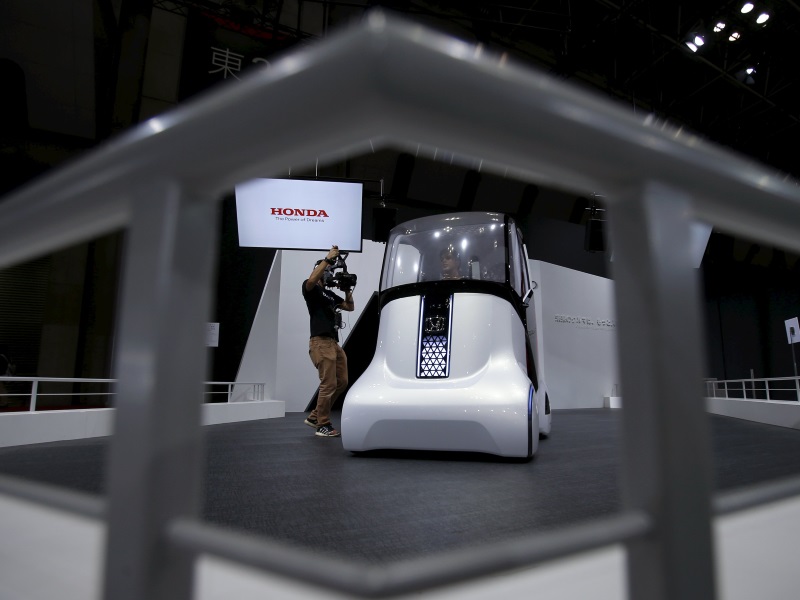- Home
- Others
- Others News
- Car Makers Battle for Tech Dominance on the Road to Self Driving Car
Car Makers Battle for Tech Dominance on the Road to Self-Driving Car

Active Speed Limiter is available on select models in Europe, but not, ironically, in the United States, Ford's home country, where road signs come in different shapes and sizes, and are often obscured by shrubbery.
So it goes on the road to the self-driving, or autonomous, car - a journey of, well, stops and starts that most experts say will take a couple decades to complete.
Meantime, advances in "semi-autonomy" - features that help handle tricky or tiresome driving situations but still require a driver's oversight - have sparked a high-tech automotive arms race, with car companies vying to launch the most advanced features.
Automakers hope semi-autonomous features will, over time, help drivers and regulators get over fears of riding in vehicles that accelerate, steer and stop themselves, making potentially life-or-death judgements.
Shorter term, car companies want these features to make driving more convenient - and cars more profitable.
"People like features that make driving easier, safer and more fun," says Joseph Vitale Jr., who heads global automotive consulting for Deloitte Touche Tohmatsu. "The question is what customers will pay for them."
Ford's Active Speed Limiter comes at EUR 560 (roughly Rs. 40,000), and it's too soon to tell how popular it will be.
Among the biggest winners for now are the companies that produce electronic sensors, cameras and software that make self-driving features possible.
The growing list includes the high-tech units of traditional automotive suppliers such as Germany's Continental AG, Israel's Mobileye Vision Technologies, and consumer-technology giants Google, Apple, Samsung Electronics Co, Sony Corp and more.
At Silicon Valley's Nvidia Corp, for example, video games remain the biggest market, but automotive revenue is the fastest-growing segment.
"We're in well over 8 million cars on the road today and will be in more than 30 million in the next three to four years," says Jen-Hsun Huang, Nvidia's president and CEO. "Future cars will sense and understand the world moving around them."
"Doing crazy things"
A big step in that direction was the traffic-jam assistance feature on the 2014 Mercedes-Benz S-Class. Now available on more Mercedes models, the Intelligent Drive system allows the car to drive itself at low speeds in traffic jams, freeing the driver from constant braking.
BMW, Honda Motor Co, Hyundai Motor Co and others have or will soon introduce similar features.
Silicon Valley's Tesla Motors recently broke new ground by downloading "autopilot" features to its newer models, just as software updates are downloaded to smartphones and tablets. Autopilot basically drives the car itself, but Tesla warns drivers not to relinquish control entirely.
On a recent investor call, Tesla CEO Elon Musk said he had seen some "fairly crazy videos on YouTube" of Tesla owners driving hands-free with autopilot, and added: "This is not good. We will be putting some additional constraints on when autopilot can be activated, to minimize the possibility of people doing crazy things with it."
Bells and whistles
For consumers, getting their first car with semi-automated features can be both exciting and daunting, especially those who haven't bought a new car in years.
"I had no idea this sort of thing was out there," says Mark Goldsmith, a Tokyo-area TV news writer. "I'd been driving a 15-year-old Jeep, which only had cruise control that you constantly had to adjust, so all these new features are a novelty."
Goldsmith recently traded the Jeep for a 2015 Volvo with a mouthful of a name - the V40 T5 R-design - and a handful of semi-automated driving features.
Those include adaptive cruise control, distance warning, blind-spot information system, "city safety," driver alert system, lane-keeping aid, road-sign information, anti-skid system and parking assist. Combined they add close to $1,000 (roughly Rs. 66,000) to the car's total price of nearly $31,000 (roughly Rs. 20,46,000).
While Goldsmith says he has yet to test all the automated features, he says the suite of functions was "definitely" a factor that helped sell he and his wife on the car.
But to other drivers, like Kirstin Houser, a communications and events manager in Frankfurt, mastering how to use all the buttons, switches and toggles to activate the automated drive functions on her family car, a 2015 Mercedes E-Klasse Kombi, was a time-consuming process which required "relearn(ing) how to drive".
"There are just too many bells and whistles on the steering column, either to push, pull, scroll, hold down, release, etc. By the time I remember which one to use, there's already a row of cars behind me honking to park my car," she said.
"Safe driving, and also understanding the general mechanics of a car, are so engrained in the way we drive that it's hard to separate that and allow our car to make those judgements."
Target 2020
Ford recently added automated straight-in, "perpendicular" parking on some models. While developing the feature, company engineers found that cars could self-park in places so tight that drivers couldn't pull out of them. They reworked the software to add pull-out capability to Active Park Assist, which is priced at $395 (roughly Rs. 26,000) in America and EUR 350 in Europe.
BMW's new flagship 7 Series sedan has a remote self-parking feature that allows the car to park itself with nobody inside. Drivers stop, hop out, push a button on the key fob, and the car takes over.
Google is holding discussions with at least half a dozen car companies with aims of launching its self-driving car system by 2020. That same year, Japan's Big Three - Toyota, Nissan Motor Co and Honda - are targeting the Tokyo Summer Olympic Games to launch and showcase cars that will largely handle themselves in city traffic, but not entirely.
"We maintain our expectation that drivers will remain in control of their cars in 2020," Moritaka Yoshida, Toyota's chief safety technology officer, said recently at a demonstration of the company's latest automated driving technology.
Nonetheless, the company's Lexus GS450 SX models equipped with cameras, radar and laser sensors changed lanes and merged smoothly in heavy traffic, without help from the driver.
The 2020 Olympics could become a venue for automotive as well as athletic competition, and not just among traditional car companies.
Tokyo-based Robot Taxi plans to bypass semi-autonomy and deploy 3,000 self-driving taxis that athletes, VIPs and tourists can summon by a smartphone app to ferry to and from venues.
"It's not about the car," the company's chairman Hisashi Taniguchi told Reuters. "We're going to generate revenue from supplying self-driving vehicles as a service, and collecting user fees. It's all about the app, and how many people use it."
© Thomson Reuters 2015
Catch the latest from the Consumer Electronics Show on Gadgets 360, at our CES 2026 hub.
Related Stories
- Samsung Galaxy Unpacked 2025
- ChatGPT
- Redmi Note 14 Pro+
- iPhone 16
- Apple Vision Pro
- Oneplus 12
- OnePlus Nord CE 3 Lite 5G
- iPhone 13
- Xiaomi 14 Pro
- Oppo Find N3
- Tecno Spark Go (2023)
- Realme V30
- Best Phones Under 25000
- Samsung Galaxy S24 Series
- Cryptocurrency
- iQoo 12
- Samsung Galaxy S24 Ultra
- Giottus
- Samsung Galaxy Z Flip 5
- Apple 'Scary Fast'
- Housefull 5
- GoPro Hero 12 Black Review
- Invincible Season 2
- JioGlass
- HD Ready TV
- Laptop Under 50000
- Smartwatch Under 10000
- Latest Mobile Phones
- Compare Phones
- OPPO Reno 15 Pro Max
- Honor Win RT
- Honor Win
- Xiaomi 17 Ultra Leica Edition
- Xiaomi 17 Ultra
- Huawei Nova 15
- Huawei Nova 15 Pro
- Huawei Nova 15 Ultra
- Asus ProArt P16
- MacBook Pro 14-inch (M5, 2025)
- OPPO Pad Air 5
- Huawei MatePad 11.5 (2026)
- Xiaomi Watch 5
- Huawei Watch 10th Anniversary Edition
- Acerpure Nitro Z Series 100-inch QLED TV
- Samsung 43 Inch LED Ultra HD (4K) Smart TV (UA43UE81AFULXL)
- Asus ROG Ally
- Nintendo Switch Lite
- Haier 1.6 Ton 5 Star Inverter Split AC (HSU19G-MZAID5BN-INV)
- Haier 1.6 Ton 5 Star Inverter Split AC (HSU19G-MZAIM5BN-INV)

















